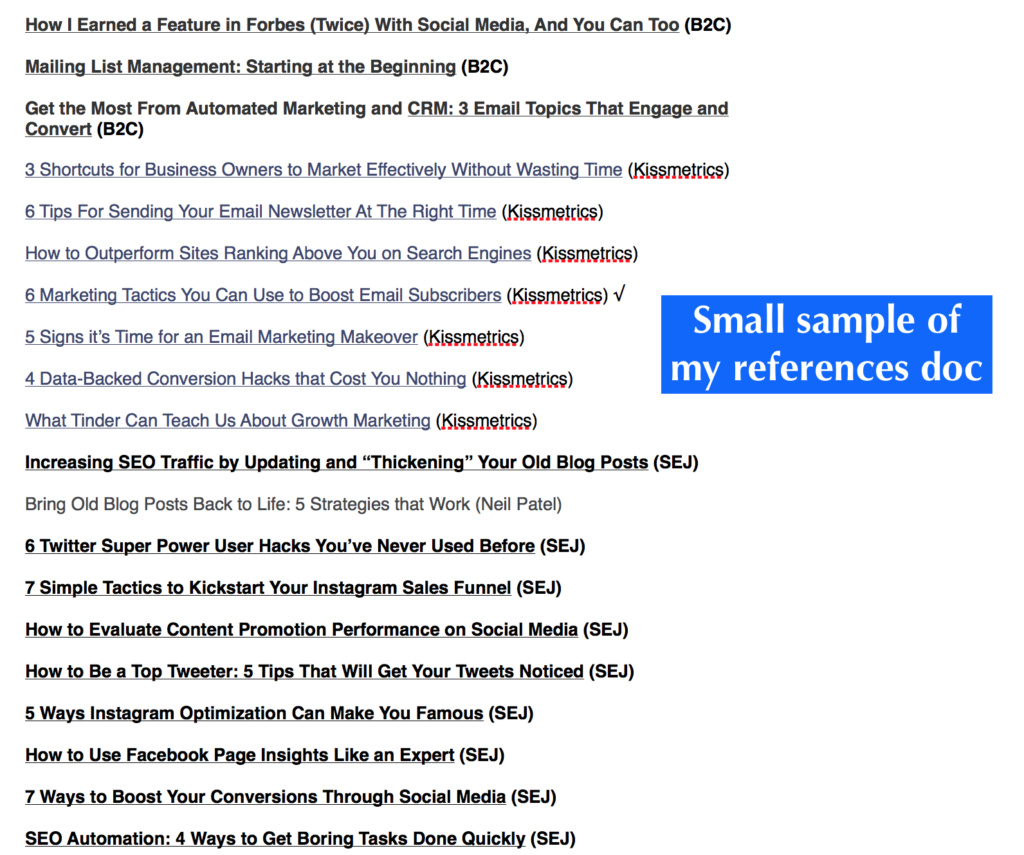
Ever wonder how top bloggers seem to utilize multiple links throughout their content? People like Neil Patel always seem to have dozens of links in each of their blog posts. How do they do it?
No, they don’t have more time than you do. We all have the same 24 hours in a given day, but the way we use those hours determines what we get.
With the right process in place, you can incorporate dozens of links within your blog posts. This post will show you how.
#1: Write Longer Blog Posts
Writing longer blog posts will present you with more opportunities for you to add more links throughout your content. It’s important to space them apart by a few sentences to not appear spammy, but the extra effort is well worth it.
Links like the one above will help to reduce my blog’s bounce rate. That means visitors spend more time on my blog and search engines respond by ranking my content higher. If you click on the bounce rate link, you’ll get led to a KISSmetrics article. Utilizing outbound links to authority sites also sends search engines a signal that your content is valuable.
This is why you’ll see people like Neil Patel use dozens of links in their content—a mix of links to their own content and to other authority sites’ content.
#2: Give Yourself More Time To Write Each Blog Post

We’ll get into advanced tactics later, but we need a strong foundation first. If you only give yourself 10 minutes to write a blog post, there’s not enough time to write an in-depth blog post and researching for links you can use in your content.
If you give yourself an hour to write the blog post, that gives you more time to discover links that would strengthen your blog post’s value. The more time you spend optimizing your blog posts with a bunch of links and providing value, the more your visitors will appreciate your brand and become subscribers.
Look at your schedule and find the 15 extra minutes you can use to strengthen your blog posts. Those extra 15 minutes can be the difference between a blog post that gets no traction and a blog post that keeps the attention of your visitors for a long period of time.
#3: Create A References Document
Most successful bloggers are voracious readers. If you don’t actively read blog posts in your niche, it’s one of the blogging habits you need to develop now. If you are actively reading other people’s blogs, you are off to a great start.
This one tactic will make it incredible easy for you to incorporate more links into your blog posts. It’s so easy that it feels like an unfair advantage. Here it is:
Every time you consume a piece of content you enjoyed, copy and paste that link into a document. As you add more links to this document, it will eventually become your reference document. I like to use the headlines as the anchor text so I don’t have to read the link to guess at what the content is about.
I group all of the links based on topic and source. Grouping links by topic makes it easier for me to find content related to the blog post I’m writing about. Including the content source prevents me from promoting the same blog too often in one blog post.

By varying the sources that you share, you can reach out to more influencers saying that you featured them in your latest blog post. The outreach will result in more people sharing your content, and those initial shares will create a ripple effect.
A reference document containing many pieces of content will help you with this objective. I add at least 20 new pieces of content to the reference document every day so I never run out of sources.
If I see one source on my list running out of links that I haven’t mentioned, I’ll read content from that source to refill that part of my reference document with more links.
#4: Update Your Older Blog Posts
Your top blog posts are your older ones. Each time you look at your stats, you’ll realize this truth. A few of your old blog posts get the lion’s share of the traffic.
These are the blog posts that you need to update with more links. You can use these older blog posts to link to your newer content. This will give your newer content more spotlight.
You can also utilize outbound links within your older blog posts to tell search engines that you’re linking to authority content. Don’t think that hitting the publish button is final. You can make changes to your new blog post on the day you publish. You can make some changes several months and even years after the fact.
You need to focus on your most successful blog post. Don’t go through all of your blog posts and make changes. You can use that time to do other things.
But your most popular blog posts need more attention than the rest so they remain popular and continue to grow.
In Conclusion
When I wrote this blog post, my references document was very new. I had less than 20 links in the document, and used a total of six links within this blog post. I recommend an absolute minimum of five links for each blog post, but as your references document grows, you can start to use dozens of links within each of your blog posts.
Part of the goal is to write a lengthy blog post so it’s easier for you to insert those links while leaving enough space in between links. If you write a 2,000 word blog post (about twice the length of those one), that gives you significantly more opportunities to incorporate links within your content.
What are your thoughts on incorporating more links into our blog posts? Do you have any tips for us? Do you have a question for me? Sound off in the comments section below.

Leave a Reply